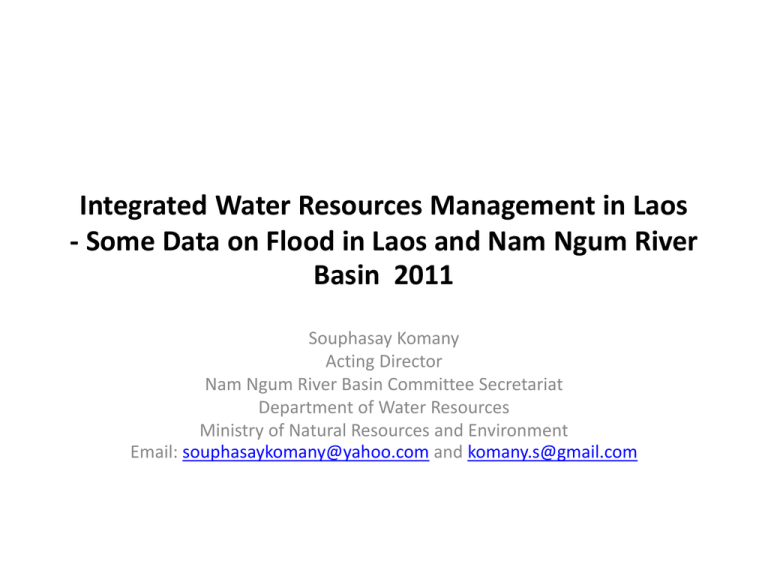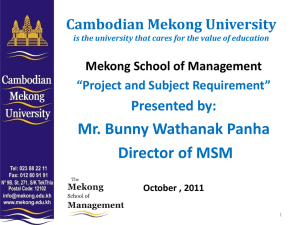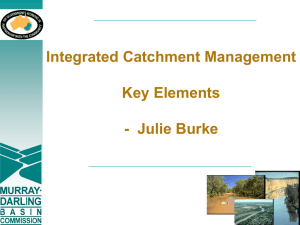Flood in Laos
advertisement

Integrated Water Resources Management in Laos - Some Data on Flood in Laos and Nam Ngum River Basin 2011 Souphasay Komany Acting Director Nam Ngum River Basin Committee Secretariat Department of Water Resources Ministry of Natural Resources and Environment Email: souphasaykomany@yahoo.com and komany.s@gmail.com Water Resources Status in Lao PDR Annual Surface Water Availability and Sectoral Consumptive Uses Surface Water Availability: 270 Billion CM3 Sectoral Consumptive Uses: 5.7 Billion CM3 5.7 Billion CM3 (2%) 8% 264.3 Billion CM3 (98%) Remaining Surface Water Flow 10% 82% Surface Water Uses Industry Agriculture Domestic 4 History – Regional Context – October 1957: Establishment of the Lower “Mekong Commission”, the Secretariat had been based in Bangkok. – …………. Mekong Committee. …... – 1978 – 1995: Interim Mekong Committee. – 1995: Mekong River Commission. • Under the Agreement on the Cooperation for the Sustainable Development of the Mekong River Basin (Mekong Agreement 1995); • Procedures for Data and Information Exchange and Sharing; • Procedures for Water Use Monitoring; • Procedures for Notification, Prior Consultation and Agreement • The Secretariat based in Phnom Phene 1998 – 2003; in Vientiane 2004 – 2010; and Co-host Location between Lao and Cambodia 2010 – 5 History – National Context • Constitution, Article 17: All organizations and citizens must protect the environment and natural resources: land, underground, forests, fauna, water sources and atmosphere. • Environmental Law 1999 specifies necessary principles, rules and measures for managing, monitoring, restoring and protecting the environment in order to protect public, natural resources and biodiversity, and to ensure the sustainable socio-economic development of the nation. 6 History – National Context • Water Law 1996 paved the way for application of IWRM principles: – “determines necessary Principles, rules, and measures relative to the administration, exploitation, use and development of water and water resources in the Lao people's Democratic Republic to preserve sustainable water and water resources and to ensure volume and quality providing for people 's living requirements, promoting agriculture, forestry, and industry, developing the national souci-economy and ensuring that no damage is caused to the environment”. • Decree to Implement the Water Law 2001provides officially cross-sectoral framework for coordination and functional arrangement: – “The decree establishes the responsibilities of different ministries, agencies and local authorities with regard to the management, exploitation, development and use of water and water resources. – The Decree shall also ensure efficient development and use, conformity with the socio-economic development planning, an increase in production, an improvement of the living conditions of the people and sustainable use of water resources”. 7 History – National Context • Legal and regulatory framework and management tools developed in a less integration and given provisions were too general with the lack of subsidiary legislations. On the other hand, their enforcement were relatively limited; – – Water Law is considered as framework legislation with limited dissemination and weak enforcement; Lake of supporting subsidiary legislation, regulations and tools; • Sectoral planning observably fragmented with insufficient communication with the lack of resources supported for implementation and fully goal achievement; 8 History – National Context • Previous River Basin / Water Resources Management: – – – – – • Establishment of the Water Resources Coordination Committee (WRCC), 1999: – • No formal RBO in-functioned; No commonly institutional arrangement – project-based arrangement; Sector-based design; Limit coordination on planning and management; Functional Conflict with the existing Lao National Mekong Committee (LNMC), since over 90% of the Lao territory is within the MRB; Concept of IRBM Confused with Integrated Watershed Management Function; 9 History – National Context • At the beginning lack of national coordination / management agency (apex body); and later the coordination agency was existed but facing with insufficient authority and less recognition; • Lake of human resources and technical capacity; • Limited understanding on IWRM at national and local levels; • Fragmented, in-updated and unqualified data and information, inconsistent data and information system; 10 Present – National Arrangement • LNMC – National Water Apex Body as part of its MRC institutional Arrangement; – Honorably chaired by Deputy Prime Minister and permanently chaired by WREA; member by vice ministers of line agencies; • Former WREA (now MoNRE) – Public Administrative Body brought about IWRM functions into official stage and provide management framework for future IWRM application by considering IRBM as a heart; • DWR – Combines LNMCS and WRCCS in one and acts as LNMC Secretariat as part of its national administrative functions; • Reconceptionalizing of IRBM and IWM Functions - Agreement between WREA and MAF on River Basin Planning and Landscape Continuum Planning, 2009; • Setting up the national Models of RBC: NN RBC and NTNK RBC; 11 Mandate of RBCs • Based on the Prime Ministerial Decree, no. 293/PM, dated 15 June 2010 1. Principles: – IWRM through consultation and participation development process in river basin area among all involved agencies, including government, private sector, communities and other involved parties; – Ensure equitable water resources use and sustainable ecosystem; – Apply mechanism for polluter / user pay fee. Mandate of RBCs 2. Location: – River Basin Committee: • • • – Non-permanent organization; Basin-based water resources management; Under the supervision of the LNMC Secretariat: • • • • Permanent organization; Institutionally located under and technically supported by WREA (Now is reorganized as under DWR of MoNRE); Has the permaent office location at a province in the basin; Acts as an advisory body and permanent office to the RBC. Mandate of RBCs 3. Organization and Membership – River Basin Committee: • • • • • • • – Chaired by one of the provincial governors in the basin and has 5 year rotation; Vice-chaired by vice governors in the basin and the Vice Head of WREA (now is being reorganized as MoNRE); Key National Departments as Members; Key Provincial Divisions in the basin as Members; Representatives of Development Groups (Hydropower, Mining, Industry and Agriculture> in the basin as Members: Representatives of Communities in the basin as Members: Prepresentatives of Multi-ethnic Groups and Mass Organizations in the basin as Members. Secretariat: • • • The DG of RBCS has jurisdictional position as same as DG of Department; Composes of DDGs, Head and Deputy Heads and staff; (Now this structure is being reorganized, which is possibly under the DWR of MoNRE). Public Administration (Legislative / Permanent Bodies) Mekong River Commission National Government River Basin Committee Ministries / Agencies MoNRE DWR / LNMC Secretariat MoNRE Depts Prov. Level RBC Secretariat Prov. Adms Provincial DoNREs Sub-Basin Committees Dist. Level Dist. Adms District OoNREs Relevant Depts / Divs Task Forces / Working Groups / Advisory Groups National Level Lao National Mekong Committee Sectoral Sub-committees / Forums Sub-basin Sub-national Basin International and Sub-international Basin Coordination Arrangement (Impermanent Bodies) Prov. Agencies Dist. Agencies 15 16 Nam Ngum RB Profile Physical Features Area 16,800 square km (7% of national area) Length 354 km Water Resources Average Flow to Mekong River 22 billion m3 / year (14% Mekong Flow) Annual Water Use 0.9 billion m3 Agriculture: 99% Urban: 0.5% Industrial: 0.1% Land Cover and Use Natural Forest 47% Shrub land / Re-growth 34% Agriculture 8% Grassland 7% Water surface 3% Urban area 0.02% Administration No. of provinces 5 No. of District 19 Population 502,000 persons (9% of Lao PDR) ISSUES: - lack of knowledge, experiences and inadequate capacity; - water use for various purposes; - hydropower development; - irrigation schemes have increasingly developed throughout the basin; - lack of sub-basin management plans - impact from water related disaster – flood & drought. Major Sectoral Water Resources Development in the Nam Ngum River Basin Major Debvelopment Present Situation Future Expectation Hydropower 5 Projects (2011) 14 Projects (2020) Irrigation 58,000 Ha (2004) Maximum Potential: 150,000 Ha Domestic Water Use 326,000 m3/Month (2006) 482,500 m3/Month (2020) Tourism 250,000 visitors (2010) 1,600,000 visitors (2020) Medium and Major Mining Over 34 Projects (2007) Expected to be largely increased Medium and Major Industries 197 plants (2008) Expected to be largely increased Other water uses Increasing Expected to be largely increased 18 The Nam Ngum- Mekong Linkage Geography IWRM instruments Mekong Basin Mekong IWRM-based Basin Development Plan Laos Nam Ngum Nam Ngum Sub-Basins Watersheds National Water Resources Strategy and Action Plan Nam Ngum IWRM Plan Nam Ngum sub-basin plans (as e.g. Nam Song and Nam Kho) Integrated Watershed Management Plans 19 NN RIVER BASIN PLANNING DEVELOPMENT PLANS 2011-15 National Province District STAKEHOLDER CONSULTATIONS WATER RESOURCES PLANS National WR Strategy 2011-15 MoNRE Strategy 2011-15 NN IWRM Plan NNRBC SUB-BASIN COMMITTEES (Districts, communities) OTHER PLANS MRC BDP & Procedures Sector plans Climate change adaptation plans MDG, PRSP etc.etc. NNRB PLAN 2011-15 ANNUAL NNRBC WORK PLANS (NNRB Secretariat) NN IWRM Planning Initiatives Key Result Areas: 1. 2. 3. 4. 5. 6. Building Capacity to Manage the NNRB; Sustainable Water Use; Optimization Hydropower Outcomes; Developing the Irrigation Potential of the Basin; River Sub-basin Management; Reducing Risks and Impacts from Water Relate Disasters. Flood Characteristics in Laos and NNRB • Floods are by far the most damaging of all the natural disasters the strike the Lao PDR. • The central and southern regions are most affected by the frequent floods. • Flooding is a regular occurrence in the Nam Ngum River Basin and casing economic loss, social hardship and the times loss life. • Flooding is also important for the maintenance of riparian and aquatic ecosystems and also contributes to improve the fertility of soils. • Flooding on the Vientiane Plains is a serious and complex problem caused by waters from the Nam Ngum River , the unregulated Nam Lik River and interaction with the waters of the Mekong river. Luangprabang Province Xiengkhuang Province Bolikhamxay Province Flood in urban center and adjacent Historical flsah flood of two districts Flood along the Mekong on the Road No.13 Vientiane Province Saravan and Sekong Provinces Flash flood of Vangvieng and Kasi Districts Historical flash flood to urban and adjacent districts Vientiane Capital Flood in urban districts Khammuan Province Flood along the Mekong on road No. 13 and Xebangfai River Champasack Province Flood at the river mount of Sedone River 23 Flood damage and impacts in Nam Ngum (2011) Provinces affected 3 provinces: Xiengkhouang, Vientiane, Vientiane Capital Districts affected 13 Villages affected 252 People affected People injured People killed Cost damaged in Nam Ngum 8 > 14 millions USD Flood damage and impacts in Nam Ngum (2011) – cont. Agriculture Hectares of Rice paddy fields affected 3,861.10 Irrigation damaged Livestock Cattle 141 head lost Poultry 6,622 head lost Fish ponds, fishes and aquaculture 179 sites Existing and Planned Hydropower Development Plan 32







